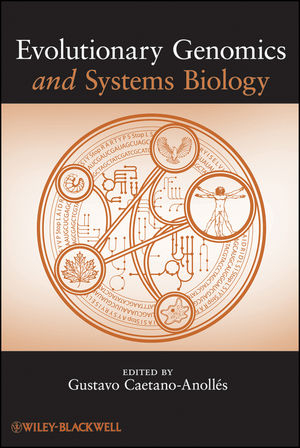
Evolutionary Genomics and Systems Biology
John Wiley & Sons Inc (Verlag)
978-0-470-19514-7 (ISBN)
- Titel ist leider vergriffen;
keine Neuauflage - Artikel merken
A comprehensive, authoritative look at an emergent area in post-genomic science, Evolutionary genomics is an up-and-coming, complex field that attempts to explain the biocomplexity of the living world. Evolutionary Genomics and Systems Biology is the first full-length book to blend established and emerging concepts in bioinformatics, evolution, genomics, and structural biology, with the integrative views of network and systems biology. Three key aspects of evolutionary genomics and systems biology are covered in clear detail: the study of genomic history, i.e., understanding organismal evolution at the genomic level; the study of macromolecular complements, which encompasses the evolution of the protein and RNA machinery that propels life; and the evolutionary and dynamic study of wiring diagrams macromolecular components in interaction in the context of genomic complements.
The book also features: * A solid, comprehensive treatment of phylogenomics, the evolution of genomes, and the evolution of biological networks, within the framework of systems biology * A special section on RNA biology translation, evolution of structure, and micro RNA and regulation of gene expression * Chapters on the mapping of genotypes to phenotypes, the role of information in biology, protein architecture and biological function, chromosomal rearrangements, and biological networks and disease * Contributions by leading authorities on each topic Evolutionary Genomics and Systems Biology is an ideal book for students and professionals in genomics, bioinformatics, evolution, structural biology, complexity, origins of life, systematic biology, and organismal diversity, as well as those individuals interested in aspects of biological sciences as they interface with chemistry, physics, and computer science and engineering.
Gustavo Caetano-Anolles, PhD, is Professor in the Department of Crop Sciences at the University of Illinois in Urbana-Champaign, Illinois. He has more than 150 well-cited original research publications in areas related to DNA technology and genomics, and holds half a dozen US patents in various areas of DNA science and biotechnology. His successful book, DNA Markers: Protocols, Applications, and Overviews, was published by Wiley in 1997.
Preface xiii Contributors xvii Part I Evolution of Life. 1. Evolutionary Genomics Leads the Way 3 David Penny and Lesley J. Collins 1.1 Introduction 3 1.2 Evolution and the Power of Genomes 4 1.3 The Problem of Deep Phylogeny and "The Tree" 5 1.4 Fred, the Last Common Ancestor of Modern Eukaryotes 7 1.5 Eukaryote Origins: Continuity from the RNAWorld? 10 1.6 Minimal Genomes and Reductive Evolution 12 1.7 Evolutionary Genomics for the Future 13 2. Current Approaches to Phylogenomic Reconstruction 17 Denis Baurain and Herve Philippe 2.1 Phylogenomics and Supermatrices 17 2.2 Phylogenetic Signal Versus Nonphylogenetic Signal 19 2.3 Probabilistic Models and Nonphylogenetic Signal 22 2.4 Reduction of Nonphylogenetic Signal Under Fixed Models 28 2.5 CAT Model 31 2.6 Case Study: Cambrian Explosion 33 2.7 Conclusion 35 3. The Universal Tree of Life and the Last Universal Cellular Ancestor: Revolution and Counterrevolutions 43 Patrick Forterre 3.1 Introduction 43 3.2 The Woesian Revolution 45 3.3 A Rampant "Prokaryotic" Counterrevolution 47 3.4 How to Polarize Characters Without a Robust Root? 50 3.5 The Hidden Root: When the Weather Became Cloudy 51 3.6 LUCA and Its Companions 54 3.7 The Problem of Horizontal Gene Transfer and Ancient Phylogenies: Trees Versus Gene Webs 54 3.8 The Nature of the RNAWorld 55 3.9 The DNA Replication Paradox and the Nature of LUCA 56 3.10 When Viruses Find Their Way into the Universal Tree of Life 58 3.11 Future Directions 59 4. Eukaryote Evolution: The Importance of the Stem Group 63 Anthony M. Poole 4.1 Introduction 63 4.2 Interpreting Trees 68 4.3 Moving Beyond the Deep Roots of Eukaryotes 70 4.4 Concluding Remarks 76 5. The Role of Information in Evolutionary Genomics of Bacteria 81 Antoine Danchin and Agnieszka Sekowska 5.1 Introduction 81 5.2 Revisiting Information 83 5.3 Ubiquitous Functions for Life 84 5.4 The Cenome and the Paleome 87 5.5 Functions Corresponding to Nonessential Persistent Genes 89 5.6 A Ubiquitous Information-Gaining Process: Making a Young Organism from an Aged One 89 5.7 Provisional Conclusion 91 6. Evolutionary Genomics of Yeasts 95 Bernard Dujon 6.1 Introduction 95 6.2 A Brief History of Hemiascomycetous Yeast Genomics 96 6.3 The Scientific Attractiveness of S. cerevisiae 98 6.4 Evolutionary Genomics of Hemiascomycetes 104 6.5 Surprises 111 6.6 What Next? 113 Part II Evolution of Molecular Repertoires. 7. Genotypes and Phenotypes in the Evolution of Molecules 123 Peter Schuster 7.1 The Landscape Paradigm 123 7.2 Molecular Phenotypes 125 7.3 The RNA Model 132 7.4 Conclusions and Outlook 148 8. Genome Evolution Studied Through Protein Structure 153 Philip E. Bourne, Kristine Briedis, Christopher Dupont, Ruben Valas, and Song Yang 8.1 Introduction 153 8.2 Structural Granularity and Its Implications 156 8.3 Protein Domains in the Study of Genome Rearrangements 158 8.4 Protein Domain Gain and Loss 160 8.5 And in the Beginning ... 161 8.6 But Let Us Not Forget the Influence of the Environment 161 8.7 Conclusions 162 9. Chromosomal Rearrangements in Evolution 165 Hao Zhao and Guillaume Bourque 9.1 Introduction 165 9.2 Genome Representation 166 9.3 Constructing Genome Permutations from Sequence Data 167 9.4 Genomic Distances 168 9.5 Reconstruction of Ancestors and Evolutionary Scenarios 174 9.6 Recent Applications on Large Genomes 177 9.7 Challenges and Promising New Approaches 178 10. Molecular Structure and Evolution of Genomes 183 Todd A. Castoe, A. P. Jason de Koning, and David D. Pollock 10.1 Introduction 183 10.2 Overview of Considerations in Studying Protein Evolution 184 10.3 Function and Evolutionary Genomics 186 10.4 Integrating Inferences to Detect and Interpret Adaptation: An Example with Snake Metabolic Proteins 194 10.5 Conclusion 200 11. The Evolution of Protein Material Costs 203 Jason G. Bragg and Andreas Wagner 11.1 Introduction 203 11.2 Protein Material Costs 204 11.3 An Example: Proteomic Sulfur Sparing 205 11.4 Episodic Nutrient Scarcity Can Shape Protein Material Costs 205 11.5 Highly Expressed Gene Products Often Exhibit Reduced Material Costs 206 11.6 Material Costs and the Evolution of Genomes 207 11.7 Material Costs and Other Costs of Making Proteins 208 11.8 Conclusions 209 12. Protein Domains as Evolutionary Units 213 Andrew D. Moore and Erich Bornberg-Bauer 12.1 Modular Protein Evolution 213 12.2 Domain-Based Homology Identification 215 12.3 Domains in Genomics and Proteomics 222 12.4 The Coverage Problem 225 12.5 Conclusion 227 13. Domain Family Analyses to Understand Protein Function Evolution 231 Adam James Reid, Sarah Addou, Robert Rentzsch, Juan Ranea, and Christine Orengo 13.1 Introduction 231 13.2 Universal Domain Structure Families Identified in the Last Universal Common Ancestor 232 13.3 Some Domain Families Recur More Frequently and Are Structurally Very Diverse 234 13.4 Correlation of Structural Diversity in Superfamilies with Functional Diversity 234 13.5 To What Extent Does Function Vary Between Homologous? 238 13.6 HowSafely Can Function Be Inherited Between Homologues? 245 13.7 HowAre Domain Families Distributed in Protein Complexes? 247 14. Noncoding RNA 251 Alexander Donath, Sven Findeib, Jana Hertel, Manja Marz, Wolfgang Otto, Christine Schulz, Peter F. Stadler, and Stefan Wirth 14.1 Introduction 251 14.2 Ancient RNAs 254 14.3 Domain-Specific RNAs 259 14.4 Conserved ncRNAs with Limited Distribution 267 14.5 ncRNAs from Repeats and Pseudogenes 276 14.6 mRNA-like ncRNAs 277 14.7 RNAs with Dual Functions 281 14.8 Concluding Remarks 282 15. Evolutionary Genomics of microRNAs and Their Relatives 295 Andrea Tanzer, Markus Riester, Jana Hertel, Clara Isabel Bermudez-Santana, Jan Gorodkin, Ivo L. Hofacker, and Peter F. Stadler 15.1 Introduction 295 15.2 The Small RNA Zoo 296 15.3 Small RNA Biogenesis 298 15.4 Computational microRNA Prediction 302 15.5 microRNA Targets 304 15.6 Evolution of microRNAs 307 15.7 Origin(s) of microRNA Families 313 15.8 Genomic Organization 316 15.9 Summary and Outlook 320 16. Phylogenetic Utility of RNA Structure: Evolution s Arrow and Emergence of Early Biochemistry and Diversified Life 329 Feng-Jie Sun, Ajith Harish, and Gustavo Caetano-Anolles 16.1 Introduction 329 16.2 Structural Characters and Derived Phylogenetic Trees 333 16.3 Applications 344 16.4 Conclusions 353 Part III Evolution of Biological Networks. 17. A Hitchhiker s Guide to Evolving Networks 363 Charles G. Kurland and Otto G. Berg 17.1 Introduction 363 17.2 Phylogenetic Continuities, Biological Coherence 367 17.3 Nested Structural Networks 371 17.4 Optimal Networks 374 17.5 The Emperor's BLAST Search Revisited 381 17.6 Will the Real Missing Link Please Stand Up? 388 17.7 All's Well 389 18. Evolution of Metabolic Networks 397 Eivind Almaas 18.1 Introduction 397 18.2 Metabolic Network Properties 398 18.3 Network Models For Metabolic Evolution 403 18.4 Dynamic Models Of Genome-Level Metabolic Function 407 19. Single-Gene and Whole-Genome Duplications and the Evolution of Protein Protein Interaction Networks 413 Grigoris Amoutzias and Yves Van de Peer 19.1 Introduction 413 19.2 Evolution of PINs 414 19.3 Single-Gene Duplications 416 19.4 Whole-Genome Duplications 416 19.5 Diploidization Phase 416 19.6 Dosage Balance Hypothesis 417 19.7 Types of Interactions 417 19.8 WGDs, Transient Interactions, and Organismal Complexity 418 19.9 Studies on PPIs of Ohnologues 419 19.10 Concerns About the Methods of Analysis and the Quality of the Data 420 19.11 The Importance of Medium-Scale Studies: the Case of Dimerization 422 19.12 Evolution of Dimerization Networks 424 19.13 Conclusions 426 20. Modularity and Dissipation in Evolution of Macromolecular Structures, Functions, and Networks 431 Gustavo Caetano-Anolles, Liudmila Yafremava, and Jay E. Mittenthal 20.1 Introduction 431 20.2 Biological Structure as an Emergent Property of Dissipative Systems 432 20.3 Information and Its Dissipation 435 20.4 Time, Thermodynamic Irreversibility, and Growth of Order in the Universe 437 20.5 Information Dissipation and Modularity Pervade Structure in Biology 440 20.6 Modularity and Dissipation in Protein Evolution 443 20.7 Conclusions 447 Acknowledgments 448 References 448 Index 451
| Verlagsort | New York |
|---|---|
| Sprache | englisch |
| Maße | 179 x 258 mm |
| Gewicht | 1056 g |
| Themenwelt | Informatik ► Weitere Themen ► Bioinformatik |
| Naturwissenschaften ► Biologie ► Genetik / Molekularbiologie | |
| Technik ► Umwelttechnik / Biotechnologie | |
| ISBN-10 | 0-470-19514-2 / 0470195142 |
| ISBN-13 | 978-0-470-19514-7 / 9780470195147 |
| Zustand | Neuware |
| Haben Sie eine Frage zum Produkt? |
aus dem Bereich


